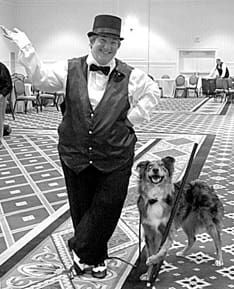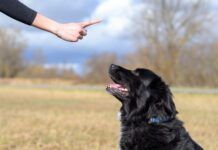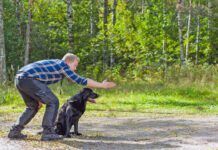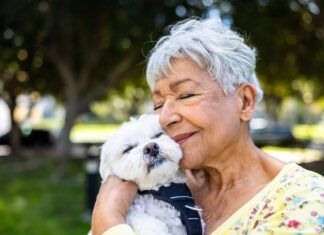MUSICAL FREESTYLE FOR DOGS OVERVIEW
What you can do…
– Attend an event where freestyle will be demonstrated so you can see for yourself how much fun the participants – human AND canine – have with the sport.
– Buy a book or videotape that teaches you some of the basics, so you can start introducing some moves to your dog.
– Join a freestyle training club for advice, support, inspiration, and further education.
– Consider the sport even if you or your dog are less than athletic; even individuals in wheelchairs can participate! And many older enthusiasts find it irresistible.
Dance fever is sweeping through the canine community. Dogs are spinning and twirling to country western, rock ‘n roll, movie theme songs, and more. What’s driving these dogs (and their handlers!) to move to the beat? It’s none other than the tail wagging sport of canine musical freestyle.
Musical freestyle is a choreographed routine performed by handlers and their dogs. A relatively new addition to the dog sport world, freestyle came onto the scene less than 20 years ago. According to a few sources, freestyle seemed to pop up simultaneously in several countries, the way dog sports often do.

Today, freestyle is an established sport today, but it continues to evolve and grow. The sport’s early beginnings may have been rooted in formal heeling. But musical freestyle has moved beyond heeling routines into a true crowd-pleasing performance sport that incorporates a variety of trick-like movements such as spinning, backing up, weaving through legs, and jumping over arms.
Freestyle is About Relationships!
We’ve all seen a couple on the dance floor that rivet an audience. When partners dance – really dance! – it isn’t just the footwork or the fancy moves that fascinate; it’s their connection, chemistry, and relationship. In musical freestyle, where the dance partners are dog and handler, the relationship and the chemistry are also key.
“I first saw freestyle on TV, watching a performance of Mary Ray and her Border Collies from England. I was moved to tears,” says Nacina Dawn, a freestyle enthusiast from Valley Ford, California. Dawn says that the relationship aspect is what first drew her to the sport. Dawn was so inspired by the bond she witnessed between Ray and her dogs that she had to try freestyle. Today, Dawn dances with her seven-year-old Golden Retriever, Candy, and chairs the Gold Coast Freestyle Guild, a division of the Canine Freestyle Federation (CFF).
Kris Hurley, a freestyler from Edmond, Oklahoma, agrees. “I think the most wonderful thing about freestyle is the relationship it builds between you and your dog,” she says. “The next best thing might be the relationship between you and other freestylers!”
Hurley, who has participated in musical freestyle since 1996, is a founding member of the Musical Dog Sport Association (MDSA), an organization that promotes the sport. She also teaches through Freestyle Dogs of Oklahoma, and dances with her three dogs, Maggie, Nellie, and Roxie.
Unlike other dog sports, where the course or expected performance is essentially the same for each team, the focus of freestyle is the individuality of routines. Each team determines the music, moves, and interactions that will highlight the physical ability and personality of each team member. This aspect of freestyle readily lends itself to building on both the dog and the handler’s strengths – and thus on strengthening their relationship.
While the relationship-building aspect of freestyle is part of what makes it so attractive, the obvious joy – and just plain fun – of dancing with your dog cannot be overlooked.
“Although I participate in conformation and agility, my dogs and I have found canine freestyle to be the most joyous!” says Dawn. She explains that while the focus of freestyle is the bond, there is simply a large dose of “let’s have FUN!” thrown into the mix.
Any Dog Can Freestyle
So far, we’ve got a relationship-building sport that is a whole lot of fun. Is there more reason to take a closer look at this sport? Definitely!
“I think the flexibility of freestyle results in the sport having a little something for everyone,” says Hurley. For example, Hurley began musical freestyle when her dog, Maggie, was already nine years old.
“Maggie had stopped really enjoying obedience, and although she liked agility, the running and jumping were difficult for her,” says Hurley. “She seemed to like the change that freestyle offered – more fun, less stress.”
Now, at an amazing 17 years of age, Maggie is still doing freestyle demos and loving it. “She’s not as quick or precise as she once was, but there is a spring in her step and a sparkle in her eye when she’s doing her routine that just makes me smile. I think freestyle has enabled her to maintain physical strength and flexibility, which has helped her as she enjoys her senior years.”
Dawn agrees and points to two of her freestyle colleagues as examples. “Judy Gamet, of dogscandance.com, dances with an 11-year-old rescue Rottweiler who has one artificial hip and one severely dysplastic hip,” says Dawn. “Margine Webb dances with her 14-year-old Chesapeake Bay Retriever who is deaf and has arthritis. Freestyle has conditioned them and increased their strength, flexibility, agility, and confidence.”
But freestyle isn’t just for older dogs or dogs with disabilities, either. Hurley does both competitions and demonstrations with her four-year-old Pug-mix, Roxie, and her eight-year-old Toy Manchester Terrier, Nellie. Dawn has earned a beginner’s freestyle title with Candy. Plus, freestyle has some distinct advantages for puppies and younger dogs.
“Freestyle can be a great activity to teach the dogs to ‘learn how to learn,'” says Hurley. “Many puppies don’t have the attention span for the precision required in obedience, or shouldn’t be really jumping until after they grow. But you can train many of the freestyle behaviors at a very young age. Learning the process of learning is a skill that will carry over into whatever other activities they may want to do as an older dog – in addition to freestyle.”
Hurley also points out that the same flexibility applies to the human side of the team. “I have a student in one of my classes who is 70 years old and is training a dog for the first time. Again, because freestyle routines can be tailored to the participants’ physical characteristics, any age, shape, size, speed, or skill can be successful in freestyle. While there may be certain moves that a dog or handler can’t do, it would not preclude them from participating in freestyle.”
Dance Illusions

Both Dawn and Hurley also assured me that the people involved in freestyle don’t have to be able to “dance,” at least not in the traditional sense, to participate in this sport. As someone who is investigating freestyle as a potential new activity for my slightly senior dogs, this has been my biggest concern!
“Although a sense of musicality can be helpful, I definitely don’t feel that being a good dancer is a requirement. It’s all about presenting an illusion of dance,” says Hurley. She explains that by adding simple gestures that match the feeling of the music, the teams appear to be dancing though there is not a formal dance step anywhere in the routine.
For example, thumbs hooked through belt-loops with a small hitch-step to a country song, or a quick head-snap and hands clapped above the head to start a tango, create the illusion of dance.
According to Hurley, one of the philosophies that MDSA promotes is that the music selected should match the natural rhythm of both the dog and the handler. “When the music selected is a good match, the team almost naturally moves in time with the music,” says Hurley.
Dawn agrees, noting that the various freestyle organizations put different emphasis on the handler movements.
“CFF does not require an athletic ‘dance’ performance by the handler,” she says. “Handlers showcase all of the beautiful qualities and strengths their dogs possess. For example, a friend of mine who no longer is able to compete in other dog sports due to an injury, stands in one area and ‘conducts’ her dog in the space around her.”
In the Spotlight
While anyone can enjoy freestyle in their living room, if you have a desire to perform, either through demonstrations or in competition, a sense of showmanship and enjoying the spotlight is very helpful. For some people and dogs, being in the spotlight presents a challenge.
“The biggest challenge I had when starting was Candy’s shyness,” says Dawn. “But with a combination of clicker training and freestyle classes, she now has more confidence and grace than any dog I have ever had. My dogs and I love freestyle for the relaxed, happy, and fun way we can express to the audience our loving relationship.”
Hurley says that another challenge many people face is that freestyle involves two entirely different skill sets – the actual training process and the creative process used to develop a routine.
“Sometimes people who are amazing dog trainers struggle with the creative process – hearing the music, visualizing a routine, etc.,” says Hurley. “And many of the creative people sometimes struggle with the details and structure needed to train the moves. Bringing the two components together can often be the biggest – and most rewarding – challenge.”
Hurley notes that her biggest personal challenge has been getting past the need to have everything perfect in both training and competition. “In training, I’ve tried to change this by focusing on the positives. Clicker training has been a real blessing. It has really changed my way of thinking. I’m not looking for errors, but focusing on the good stuff.”
Moving to the Music
The first step in developing a musical freestyle routine is picking the music. The primary consideration is how well it fits the natural movement of the dog and handler; its rhythm needs to complement the dog’s and the handler’s rhythm, too. The music should also highlight the personality of the team. Music can create a mood that reflects the seriousness, power, or playfulness of the team. Or it can conjure an atmosphere of romance or joy.
“You also must pick a song that you really like,” says Dawn, “because during training and practice, it will be played over and over.”
Uncommon Moves
Once you have a music choice, the moves in a routine are designed to complement the music. The moves used in freestyle can be quite varied, depending on if the routine is being developed for competition, demonstration, or just for fun.
“The only move I consider to be a ‘required’ move is attention,” says Hurley. She defines attention in this context as “being focused and engaged with the handler,” not necessarily the “look straight at me and don’t look away” attention that is often associated with traditional obedience.
The need for focus and attention is in part because it is considered a demonstration of the bond between the handler and dog, but also because it is necessary for the dog to see the handler’s cues within the routine. Hurley notes that “attention” is not really an indication of the true bond between a dog and handler, but rather is a way to present that connection to the audience.
Other movements, however, are commonly incorporated into freestyle routines. Traditional heelwork, for example, is often at the foundation of a dance. Heelwork includes right and left side heeling, turns with the dog in the heel position, and right and left side finishes.
Backing up is another common movement in freestyle routines. Backing can be done with the dog in the right or left side heel position, with the dog in front of the handler, or with the dog backing away from the handler.
Sidestepping or lateral moves are often incorporated. Lateral movements can be done in conjunction with the handler’s movements, in a right or left side heel position. Sidestepping can also be done with the dog moving away from the handler, or with the dog moving in front of the handler.
Circles can be incorporated where the dog circles the handler or another object. Spins, where the dog turns in a 360-degree circle independent of the handler, are also popular in freestyle routines.
Other more advanced moves include a dog weaving between the handler’s legs. This can be done as a figure 8, as a moving weave through the legs, or when a dog simply goes through the handler’s legs. Teams can also incorporate tricks such as rolling over, crawling, or jumping. Distance-work (when a dog does any of these movements away from the handler) is also considered to be advanced.
Hurley emphasizes that you don’t have to do anything that isn’t comfortable for the dog. “If there is a move or type of move that doesn’t work well for my dogs, or that they don’t like, then I don’t have to do them,” says Hurley. This takes the stress and frustration out of training; the pressure to make a dog do something specific is completely removed.
“Quite often, the moves incorporated into the routine are moves the dogs do naturally during play. And because I’m not worrying about something going wrong or or my dog just not getting a certain move at a certain time, I’m more relaxed and we can enjoy the interaction and time working together.”
Showing Off Your Moves

It is important to note that in a freestyle competition, certain movements may be required at each level, depending on the organization. For example, in CFF (the organization Dawn is involved with), a beginning routine is done on-lead, and should include specific elements of heeling, working in front, turns or pivots, and spins or circles.
There are four levels of competition in CFF, and in the most advanced level, the routine is done off-leash and includes distance work, lateral movements, and backing up. All levels can also incorporate movements like weaving through legs, crawling, rolling over, and jumping over arms or legs. Even in competition, however, the required elements allow for a great deal of flexibility and creativity.
Plus, there are quite a few different organizations that promote freestyle, and each has its own unique philosophy. By investigating the different avenues for competition, a team is sure to find a match that will work for them. And for demonstration, exhibition, or “just for fun” freestyle routines, of course, anything goes.
Unexpected Benefits of Musical Freestyle for Dogs
If competing is not your thing, Dawn emphasizes, you can take your dance “on the road” in a variety of other ways. “Thrill your friends, bring cheer to those confined to hospitals or nursing homes, or promote responsible pet guardianship to children at schools,” she suggests.
“Although we enjoy competing, the majority of our performances are ‘dancing for a cause’ such as Northern California Golden Retriever Rescue, animal shelters, humane societies, rescue benefits, and various canine sporting events,” says Dawn. “Candy is also a registered therapy dog through the Delta Pet Partners and performs at hospitals and nursing homes.”
Hurley echoes the sentiment that competition isn’t the only venue for freestyle. “Since I’ve come from a competitive background, freestyle competitions seemed like a logical choice. However, I’m finding that I am beginning to enjoy the demonstrations more than the competitions.
“Freestyle is a great way to show what you can accomplish with positive training methods. And since several of us perform with rescue dogs, it really helps show what great dogs rescues can be,” she adds.
Hurley says she has also performed for community events like the Alzheimer’s Walk and for senior and children’s groups. “You get to have fun with your dog AND make people smile. It doesn’t get much better than that.”
Getting Started in Musical Freestyle
Kris Hurley, freestyle competitor, teacher, and founding member of the Musical Dog Sport Association, suggests that the first step for people interested in musical freestyle is to seek knowledge. “There are so many wonderful resources available to freestylers – e-mail discussion groups, training videos, competition videos, seminars, workshops, and classes. All these resources can really help a team get started,” says Hurley. “Since seminars and classes are becoming popular, some people think they need a class or seminar to get started. I think it is important to remember that many of the top freestylers trained on their own.”
If you haven’t yet seen musical freestyle in action, you might want to visit the Musical Dog Sport Association’s Web site where you can view a short video of Hurley and her dog Maggie performing to “Hang ‘Em High.” The Web site also has videos of other members, including a well-known musical freestyle routine (thanks to e-mail and the Internet), Carolyn Scott and Rookie dancing to “You’re the One That I Want” from the movie, Grease.
Mardi Richmond is a writer and trainer who shares life with her human partner and two wonderful dogs in Santa Cruz, California. She is the co-author of Ruffing It: The Complete Guide to Camping with Dogs.






